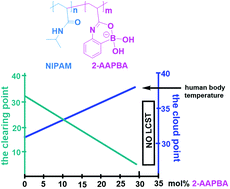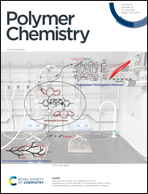The influence of 2-acrylamidephenylboronic acid on the phase behaviour of its copolymers with N-isopropylacrylamide in aqueous solution†
Abstract
In this study, we report the synthesis and phase behaviour of statistical p(N-isopropylacrylamide-co-2-acrylamidephenylboronic acid) P(NIPAM-co-2-AAPBA) copolymers. They were obtained via free radical copolymerization of NIPAM and the pinacol ester of 2-acrylamidephenylboronic acid. The influence of copolymer composition on the demixing/mixing temperature was investigated by means of UV/Vis spectrometry, DLS, DSC, and 1H NMR spectroscopy. The turbidity experiments revealed the gradual increase of the cloud point with the increase of 2-AAPBA content in the copolymer up to 37 °C at 30 mol%. The copolymer with 45 mol% did not display any transition. For copolymers displaying the cloud point, the hysteresis in the demixing/mixing temperature was observed. Transmittance measurements, DLS, and 1H NMR spectroscopy demonstrated that the phase transition was sharp upon heating, whereas the phase transition of the copolymer upon a decrease of temperature occurred in a much wider temperature range. Moreover, the NIPAM copolymer with 5 mol% 2-AAPBA content displayed 5 °C hysteresis, whereas for the copolymer containing 30 mol% 2-AAPBA it reached 25 °C. Actually, nanoparticles were formed from the copolymer with 30 mol% of 2-AAPBA above the cloud point, which were stable upon cooling to 5 °C showing the potential for drug delivery applications. Raman spectroscopy applied for the analysis of an aqueous solution of NIPAM copolymer with 15 mol% content heated over the cloud point revealed the appearance of a vibrational band at 753 cm−1 characteristic of boroxine, i.e., boronic acid anhydride, the formation of which explains the broadening of the hysteresis. The detailed analysis of experimental data supported with DFT calculations evidenced the presence of other vibrational bands of 2-AAPBA anhydride (780, 957 and 999 cm−1). This is the first report of boroxine formation upon the phase transition of boronic acid-based thermoresponsive copolymers.



 Please wait while we load your content...
Please wait while we load your content...